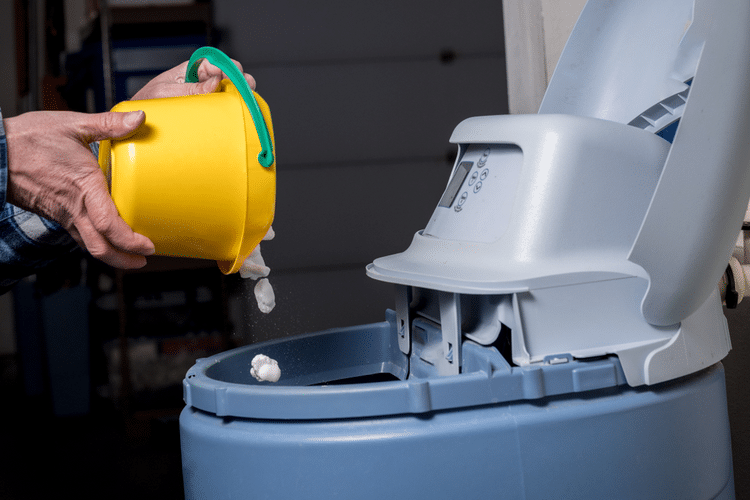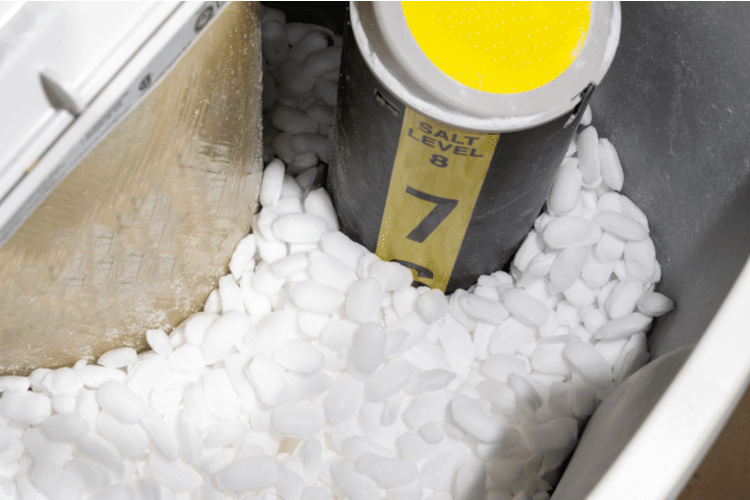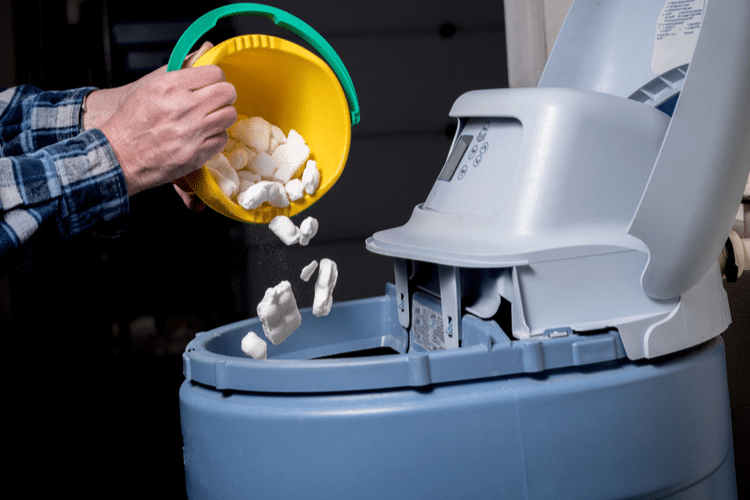You should add salt to your water softener every 4 – 8 weeks or whenever there’s low salt level in the brine tank.
Traditional water softeners soften water through ion exchange. With this technology, a negatively charged resin attracts, traps, and replaces mineral molecules with sodium ions in the primary tanks of softening devices.
For this process to work efficiently and without interruption, the resin needs to be cleaned and recharged every once in a while. This is done using water softener salt, which goes to the secondary tank of a softening unit, also known as the brine tank.
Once every week, a brine solution prepared in the brine tank travels through the whole system, cleaning the resin of the trapped minerals and recharging it with the new sodium ions found in salt. Also known as the regeneration cycle, this process ensures that the unit keeps doing its job efficiently.
Considering the importance of salt for the whole water softening process, the questions of when and how to add it are super-important. Let’s answer them so that you know how to maintain your softener properly.
When Should I Add Salt to My Water Softener?
You should add salt to your water softener once every 4 to 8 weeks or whenever the salt level in the brine tank either falls below the fill line in the tank, or the tank is less than a quarter full when there’s no water inside it.
Depending on the size of the softening device, the manufacturer guidelines, and the water hardness in your home, you may need to do it a lot more frequently.

Most brine tanks have a fill line that indicates whether the salt level is too low. The fill line is typically at the one-quarter mark of the brine tank, so if your salt level is below one-quarter of the tank, then it’s time to add more salt.
Water softeners may go through salt faster or slower depending on the water hardness in your area, so try to keep a regular schedule of checking your brine tank, ideally once a month, to figure out how often your particular unit needs it.
If you don’t want to check the salt level manually, you can use a digital salt monitor. The monitor will alert you, usually via a connected smartphone app, when the salt level is too low and the brine tank needs a refill.
What Are Signs That Water Softener Is Running Out of Salt?
Sudden signs of hard water will indicate that your water softener is running out of salt, be it in the form of stains left by water on glassware and kitchenware, faded clothes from the washer, or unusually dry skin and hair after you get out of the shower.
Without a proper salt solution, the water softening system won’t be able to clean or recharge itself, so you’ll start experiencing the effects of hard water. If you ignore them for a while, the effects will progress to mineral buildup in the pipes and eventually cause low water pressure, clogged drains, or streaky white stains in your tub or sink.
In addition to low salt levels, you should also check for salt bridges. A salt bridge is a mass of salt that’s clumped together and hovers over an air bubble, so it can look like your tank is half full when it’s time to add more salt. This can prevent the system from preparing a solution with the adequate brine level (a salt-to-water ratio that’s compatible with the softening unit and appropriate for the level of water hardness) to regenerate itself.
If you’re seeing the signs that you are running out of salt, you may have a salt bridge in the brine tank which doesn’t allow water to make contact with the soluble portions of salt.
How to Check Current Salt Level
Checking the salt level in your water softener is as easy as lifting the lid and looking in the brine tank. The alt level should be around halfway, and if you see it below that, it’s time to add more salt.

There are also modern devices that allow you to check the salt level digitally. In these systems, there’s a digital monitor inside the brine tank and a BlueTooth-connected salt head that sends alerts to your phone when you need to add more salt.
A digital salt monitor is an excellent option to ensure you keep your water softener working if you find yourself forgetting to check your salt level on a regular schedule or have suffered from hard water after forgetting to add salt.
So, a system that has a digital salt head, like the Springwell SS1, which is the #1 on our list of best water softeners, can easily take care of this job for you.
If you don’t have a unit with a digital salt monitor, you’ll have to check your salt level manually.
How Often to Add Salt to Water Softener
In the beginning, you should check your salt level once a month. Over time, you’ll gain an understanding of the amount of time it takes for the salt to get used up in your particular unit and situation. How regularly you need to add salt to your tank will depend on your particular area, water usage, and specific water softener.
If you have particularly hard water in your area or high water usage in your household, you will probably add salt more often, maybe once in three weeks.
The age of the water softener is another factor, as older models generally require more salt than newer models. Lastly, a softening unit with a properly-sized grain capacity will consume less salt than a small one, so it’s imperative to know how much water softener grain capacity the unit you pick needs to have for your particular household needs.
How to Add Salt to Water Softener
Adding salt to a water softener is simple; Just lift the lid of the salt brine tank and pour in the right amount of salt following manufacturer instructions. Make sure to inspect the salt brine tank and the salt level before adding any salt.

Before resuming normal operation, check for salt bridges, whether there’s any standing water inside the brine tank, and whether there’s any dirt or debris inside the tank that you need to clean.
Can I Fill My Water Softener to the Top With Salt?
No, you should never fill a water softener to the top with salt. Filling the brine tank with too much salt will cause salt bridges, which can negatively affect your water softener’s performance.
The ideal salt level for a water softener depends on the manufacturer’s guidelines and your water hardness, but it’s typically a quarter of the tank. So, only ever fill it to that level and only add salt if the level has dipped below the halfway point.
Conclusion
Many contemporary water softening devices feature a digital salt head that alerts you when to add more salt to the brine tank and how much to add. These devices have computers that measure how much salt is needed to regenerate the resin in the most efficient way by taking data such as water hardness into account.
However, if you have an old unit that doesn’t have such a feature, you need to check the salt levels inside the brine tank at least once per month manually. If the salt levels are lower than the levels recommended by your manufacturer (mostly a ¼ of the tank), then you should add more salt.
When checking the salt levels, it’s also crucial to check if there are any issues with the brine tank, like salt bridges or standing water.
Lastly, you shouldn’t add more salt than the manufacturer recommends; otherwise, the device might suffer from salt bridges and clogging in the brine or drain lines.